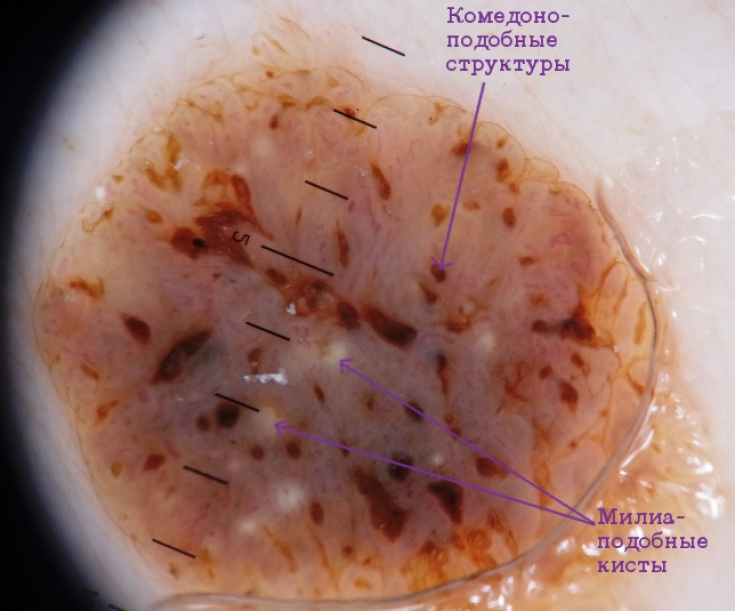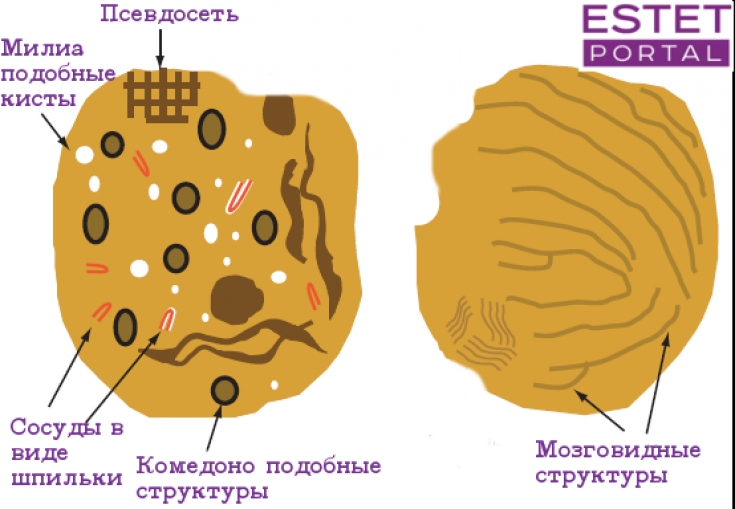Seborrheic keratosis is one of the most common neoplasms on the skin. Studies show that every 50 people have at least one element of the lesion. A feature of seborrheic keratosis is & nbsp; the fact that the formations are clearly defined and stand out above the surface of the skin, which often causes discomfort to the patient. The danger of these neoplasms is that behind the harmless "age marks" can hide skin cancer and melanoma. About how the elements of seborrheic keratosis differ from other skin lesions, as well as about effective methods of treating this disease, read on estet-portal.com in this article.
Why seborrheic keratosis can be dangerous
Seborrheic keratoses usually have rather specific dermatoscopic features.
In some cases, melanocytic lesions, especially dermal nevi, congenital nevi, Spitz nevi, and melanoma nodosum, may have similar clinical and dermoscopic features to seborrheic keratosis.
Very often, markers of melanoma and basal cell carcinoma can join the characteristic manifestations of seborrheic keratosis. This gives reason to consider this neoplasm malignant, which requires immediate surgical excision with further histopathological examination. major dermatoscopic signs of seborrheic keratosis;
• seborrheic keratosis and melanoma: differential diagnosis;
• main treatments for seborrheic keratosis.
Main dermatoscopic signs of seborrheic keratosis
The elements of seborrheic keratosis can have a very different color. But all of them are characterized by certain dermoscopic features, which include:
 • cerebral structures;
• cerebral structures;
• uniform gray-black dot pigmentation.
Seborrheic keratosis is most often characterized by the appearance of several characteristic signs. However, if dermatoscopy shows the presence of questionable markers of malignancy, it is best to excise the neoplasm.
Seborrheic keratosis and melanoma: differential diagnosis
Melanoma
and seborrheic keratosis — These are age-related diseases. However, if elements of seborrheic keratosis most often appear on the face, chest, shoulders and back, then melanoma can more often affect the neck, arms, legs, and also the back area. Unlike melanoma, the occurrence of seborrheic keratosis elements is not directly dependent on sun exposure. Both of these diseases have a hereditary predisposition, and therefore, for their differential diagnosis, it is necessary to carefully collect anamnesis. Melanoma can be disguised as elements of seborrheic keratosis, however, it will always remind you of its characteristic features: asymmetry, uneven color of the neoplasm, its diameter and growth rate.  Most often, seborrheic keratosis does not require treatment. Removal of formations is carried out for aesthetic reasons. It is also recommended to remove the neoplasm if it is often subjected to mechanical stress or trauma, which is important for the prevention of its malignant degeneration.
Most often, seborrheic keratosis does not require treatment. Removal of formations is carried out for aesthetic reasons. It is also recommended to remove the neoplasm if it is often subjected to mechanical stress or trauma, which is important for the prevention of its malignant degeneration.
Electrocoagulation and curettage are also used to eliminate elements of seborrheic keratosis. After removal of these elements, there is usually no scarring, however, loss of pigmentation in this area can be a problem for people with swarthy and dark skin.
Read also:
Dangers of the active sun: why actinic keratosis occurs









Add a comment